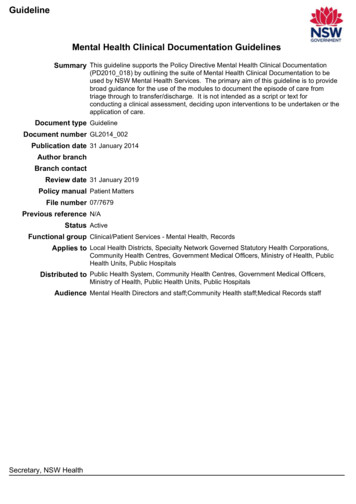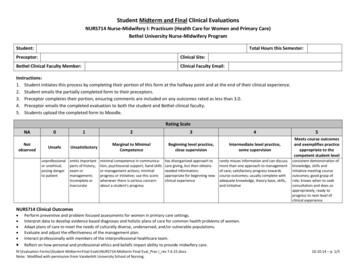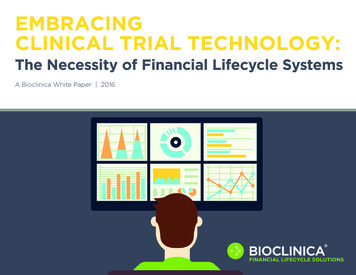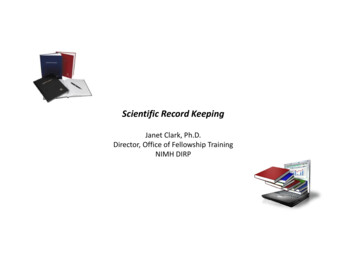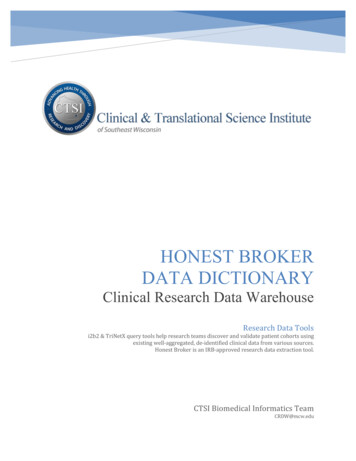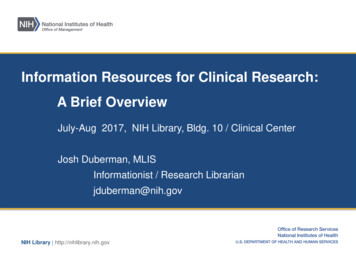
Transcription
Information Resources for Clinical Research:A Brief OverviewJuly-Aug 2017, NIH Library, Bldg. 10 / Clinical CenterJosh Duberman, MLISInformationist / Research Librarianjduberman@nih.govNIH Library http://nihlibrary.nih.gov
Johns Hopkins University (JHU)2001 Asthma StudyHealthy volunteer died after hexamethoniumadministration by inhalationPI didn’t find potential toxicity despite– “standard PubMed search” &– consulting “standard current editions of textbooksof pharmacology & pulmonary medicine”- JHU Report, 7/01: Report of Internal Investigation into the Death of a VolunteerResearch Subject, Johns Hopkins University, t of internal investigation.htm- J Savulescu and M Spriggs, The Hexamethonium Asthma Study and the Death of aNormal Volunteer in Research, J. Med. Ethics, 2002; 28;3-4, PMID H Library http://nihlibrary.nih.gov
JHU 2001 Asthma Study – resultsJHU research oversight was improved“requiring investigators to collaborate with a librarian and a pharmacistto strengthen literature searches to help search appropriate databases forpotential side effects.”Hopkins Response to FDA Observations, JHMI Office of Communications andPublic Affairs, R/010907A.htmGuidelines were established at JHU & elsewhereGuidelines for Determining an Adequate and Comprehensive Literature Search ofDrug and Device Safety for Use by Investigator and Institutional Review Boards,Institutional Review Board, Mount Sinai School of Medicine, 1/03,http://www.mssm.edu/static elines.pdf3NIH Library http://nihlibrary.nih.gov
Lecture ObjectivesOverview of clinical information resources, scope andcapabilities, with links to more information:– introduction to information resources – characteristics &questions to ask– PubMed, Embase & other databases, both free &subscription-based– internet search engines & other information resources– search tips & issues to consider when conducting orrequesting an information search4NIH Library http://nihlibrary.nih.gov
Major focusSearching for adverse effects & protocol development;applicable to many other topics in clinical research“Introduction to the Principles and Practice of Clinical Research”, NIHClinical Center course, llecture, 3/7/16 http://videocast.nih.gov/launch.asp?19530- relevant chapters in textbook, “Principles and Practice of ClinicalResearch” JI Gallin & FP Ognibene, eds., 3rd ed., Elsevier, 0123821676 3 - Researching a Bioethical Question 10 - Unanticipated Risk in Clinical Research – 1990sfialuridine (FIAU) clinical trials at the NIH - also see “Review ofthe Fialuridine (FIAU) Clinical Trials, FJ Manning & M Swartz,eds., Institute of Medicine, National Academy Press, 1995http://www.nap.edu/openbook.php?record id 4887 32 - Writing a ProtocolNIH Library http://nihlibrary.nih.gov5
Information Resources: questions Origin – lab data or journal article or database or reference/textbook;- publication cycle of new research: idea (request funding) preliminary findings (letters to the editor, submit patent application tobe published in 18 months) research report (conference literature) publish research (peer-reviewed journals) popularize research (newspapers, websites) repackaged research (reviews, texts, guidelines) Content – scope/ subjects covered / comprehensiveness; exactly what’sin a record, full text or titles/abstracts/keywords Capabilities – search technology, interface & added features;wildcards, Boolean logic; thesaurus; cited references/similaritemsNIH Library http://nihlibrary.nih.gov6
Information Resources: more questions Access –readily available or must be ordered; “free” vs. fee Business Model – who pays? - affiliations/sponsorship/bias Familiarity – sources you know how to search& sources you’veheard about- Are there other important sources, changes, or updates?NIH Library http://nihlibrary.nih.gov7
https://nihlibrary.nih.govNIH Library http://nihlibrary.nih.gov
NIH Library http://nihlibrary.nih.gov
NIH Library http://nihlibrary.nih.gov
NIH Library http://nihlibrary.nih.gov
NIH Clinical Research Information System(CRIS) - access to NIH LibraryNIH Library http://nihlibrary.nih.gov
PubMedUS National Library of Medicine (NLM) database – refers to 27 M articles from 5,600 biomedical journals in 39 languages– medicine, nursing, dentistry, veterinary medicine, allied health & preclinical sciences– currently includes references from 1940s - present, with some older items– free access online – www.pubmed.gov; NIH staff should click‘PubMed@NIH’ under ‘Quick Links / Databases’ at the NIH Librarysite http://nihlibrary.nih.gov to access full text of subscribedjournals– bibliographic database with author-provided abstracts– added indexing terms - MeSH (Medical Subject Headings) thesaurus– links to other resourcesNIH Library http://nihlibrary.nih.gov13
PubMed - SearchingUnderstand PubMed to get comprehensive results Search Aids available by clicking ‘Help’ - online bookhttp://www.ncbi.nlm.nih.gov/books/NBK3827/» includes Quick Start & FAQs at lower left» ‘PubMed Tutorials’ - web-based & interactive Online training, tutorials, webinars, instruction materials 042010P.html MeSH – added subject headings often change over time My NCBI – save searches, get updates while trial is in progress Filters - not always obvious; ‘clinical trial’ filters don’t includeall observational studies Advanced Search: Search Builder – combine search results;Details - shows what was searched;phrase (string) searching: “ ” is only sometimesNIH Library accurate http://nihlibrary.nih.gov14
Public access at www.pubmed.govNIH Library http://nihlibrary.nih.gov
PubMed searching – cont’dJHU internal investigation found different PubMed resultsdepending on the terms searchedTerms searched# Resultshexamethonium inhalation lung injuryhexamethonium inhalationhexamethonium lunghexamethonium lung toxicityhexamethonium lung hypersensitivityhexamethonium lung fibrosis # Useful0 hits42 hitsnot reported4 hits16 hits3 hits-03032– possibly due in part to limited coverage of older material & MeSH term changesover time - see Hexamethonium entry http://www.ncbi.nlm.nih.gov/mesh/68018738- JHU Report, 7/01NIH Library http://nihlibrary.nih.gov16
Basic Searching TipsHow Search Works – typically every word in record is indexed &the index is searched; success depends on: File content or scope Individual record content (bibliographic info, abstract if it’savailable, indexing/keywords) Problem of categories & group names - thesauri, classificationschemes Transparency/reproducibility of search algorithms & processes Additional search terms automatically added – plurals,synonyms, etc.Build concept-based searches - first broad, then narrow use synonyms & group similar concepts together, and take controlled vocabulary terms into account - for example:NIH Library http://nihlibrary.nih.gov(ganglionic blockers OR hexamethonium) AND lung
PubMed record - default formatNIH Library http://nihlibrary.nih.gov
PubMed record - expandedNIH Library http://nihlibrary.nih.gov
PubMed - Older InformationPubMed now covers back to mid-1940s with some earliercoverage; older information is available in print sources – 3 examples:– “Lung Changes During Hexamethonium Therapy for Hypertension”,British Heart J., 1954 – key article but- ‘toxicity’ or ‘adverse effects’ not in PubMed record– ‘hexamethonium lung’ occurs in titles of 2 articles from 1956 & 1962- indexing included ‘toxicity’ or ‘adverse effects’– Cited reference searching could provide additional access- more recent articles refer to older articles– 1966 and all that--when is a literature search done?, F McLellan, The Lancet,August 25, 2001, v358 i9282 p646http://www.ncbi.nlm.nih.gov/pubmed/11530164NIH Library http://nihlibrary.nih.gov20
NIH Library http://nihlibrary.nih.gov
NIH Library http://nihlibrary.nih.gov
NIH Library http://nihlibrary.nih.gov
NIH Library http://nihlibrary.nih.gov
NIH Library http://nihlibrary.nih.gov
NIH Library http://nihlibrary.nih.gov
NIH Library http://nihlibrary.nih.gov
NIH Library http://nihlibrary.nih.gov
PubMed record from 7/2017PubMed record from 3/2016NIH Library http://nihlibrary.nih.gov
NIH Library http://nihlibrary.nih.gov
More Information SourcesComprehensive searches usually require multipleinformation sources– Different sources have areas of specialization but may overlap– Many sources are available from NIH Library – some must besearched by NIH Library staff who may request a CAN number– Examples of some information sources follow; see websites fortutorials & more information– different versions of these sources may be available withvarying coverage and capabilities– many other sources may also be important for a givensearch31NIH Library http://nihlibrary.nih.gov
Embase Covers pharmacological & biomedical literature, with 33 M recordsfrom 8,500 journals in 40 languages– key clinical medicine subscription database, European based– NIH-accessible file www.embase.com covers 1947 – present(Resources article databases A-Z list Embase )– Includes all of Medline (not PubMed), and additional material, usingEmtree index terms, often more specific than MeSH - 15.pdf– coverage of drug side effects/interactions, toxicology,biotechnology, medical devices, health l health, conferences, &alternative/complementary medicine– Getting Started /8266Webinars /9547,10040NIH Library http://nihlibrary.nih.gov32
Embase vs. PubMed “Lung Changes During Hexamethonium Therapy forHypertension”, British Heart J, 1954PubMed – doesn’t include abstract, ‘toxicity’ or ‘adverse effects’Embase – includes abstract, ‘dyspnea’ & ‘edema’ (& British spellings),but not ‘toxicity’ or ‘adverse effects’ “Hexamethonium lung; report of a case associated withpregnancy”, J Obstet Gynaecol Br Emp, 1956PubMed – no abstract, but good MeSH indexing termsHexamethonium Compounds/*adverse effectsEmbase – includes ‘edema’ & abstract, but not ‘adverse effects’ : “ awoman of 37, treated with hexamethonium compounds diedafter the birth of a live infant Treatment with hexamethoniumdrugs from the 17th week. Severe, ultimately fatal,respiratory disease developed during theNIH35thweek ”Library http://nihlibrary.nih.gov33
At bottom of page:NIH Library http://nihlibrary.nih.gov
At top right:NIH Library http://nihlibrary.nih.gov
NIH Library http://nihlibrary.nih.gov
NIH Library http://nihlibrary.nih.gov
NIH Library http://nihlibrary.nih.gov
NIH Library http://nihlibrary.nih.gov
NIH Library http://nihlibrary.nih.gov
Cited References & RankingWeb of Science – subscription-based, includes multidisciplinary indexescovering 12,000 journals from 1900 – present, books and conferenceproceedings; complete citation counts for all records; many lackabstracts/indexing- reference guide http://wokinfo.com/media/pdf/qrc/webofscience qrc en.pdf- recorded training http://wokinfo.com/training support/training/web-of-science/Scopus - subscription-based, covers scientific, technical, medical,humanities & social science literature; 21,500 journals from 1823 – present,books and conference proceedings; many records include abstracts;complete citation counts for indexed articles from 1996 – present- Useful conference coverage & affiliations/institutions- ‘Help’ at upper right, lp.elsevier.com/app/answers/list/p/8150/c/0andBoth are useful in obtaining citation rankings of authors’NIH Library publications http://nihlibrary.nih.gov41
Clinical Decision Resources – subscription-basedMicromedex - summaries & detailed monographs for world-wide marketed drugs;names, actions, indications, dosing, toxicology, drug interactions, comparisons,product lookup & adverse effects;- ‘Help’ in upper right corner – links to Training, Search Tips, Results, Tools, etc.- “had lung toxicity as the first side effect of hexamethonium” (JHU Report, 7/01)- mine for comparative drug information, i.e. hypoglycemic data for anti-diabetesdrugs as compared with MetforminLexicomp / AHFS - clinical decision support tools and databases including detaileddrug monographs from AHFS (American Hospital Formulary System from ASHP,the American Society of Health-System Pharmacists)- see http://www.wolterskluwercdi.com/lexicomp-online/- User Guide at http://online.lexi.com/lco/help/lco-ug.pdfUp To Date - clinical decision support system for point-of-care; etiology, diagnosis &treatment questions; peer-reviewed text includes drug and evidenced-basedinformation; currency varies; references have links to NIH full-text subscriptions- ‘Help’ at upper right, with links to FAQ, Demos, User Manual, & Quick Starthttp://www.uptodate.com/home/helpNIH Library http://nihlibrary.nih.gov42
Evidence-Based Information:Secondary SourcesCochrane Library www.cochranelibrary.com - Regularlyupdated subscription-based collection for practitioners, patients &policy makers; includes: Systematic reviews of interventions; extensive abstracts inPubMed; search for: “Cochrane Database Syst Rev”[TA] Evaluations of effectiveness of health care interventions Clinical trial reports (published/unpublished) NIH staff have access via NIH Library Free in some countriesGuidelines.gov www.guidelines.gov - Frequently updated evidencebased guideline clearinghouse from the Agency for Healthcare Research& Quality (AHRQ), HHS Extensive filtering Ability to compare several guidelines side-by-sideNIH Library http://nihlibrary.nih.gov43
NIH Library http://nihlibrary.nih.gov
Clinical Trial Informationclinicaltrials.gov www.clinicaltrials.gov- registry maintained by NIH; not limited to NIH-funded researchInternational Clinical Trials Registry Platform (ICTRP)- approx. 20 registries, maintained by World Health Organization,http://www.who.int/ictrp/en/Cochrane Library – published & unpublished clinical trial reportsPharmaprojects (formerly Pipeline) – subscription based drugs-indevelopment database; detailed drug profiles including therapy, mechanism,biological targets, development history & clinical trial informationFAQ http://nih-pipeline.citeline.com/CpHelp.aspx ; Quick uick%20Start.pdfNIH Library http://nihlibrary.nih.gov45
Clinical Trial Information - CaveatsDespite policies, many trials are not properly registeredMann E, et al, Compliance with trial registration in 5 core journals of clinicalgeriatrics, Age Ageing 2014; PMID 6Hakala A, et al, Accessibility of trial reports for drugs stalling in development,BMJ 2015; PMID 9Weber WE, et al, Trial Registration 10 years on, BMJ 2015; PMID 8Take-away: read critically; data & insights can come from both old andnew resourcesPrasad V, et al, A decade of reversal: an analysis of 146 contradictedmedical practices, Mayo Clin Proc 2013; PMID 23871230NIH Library ov/pubmed/23871230
clinicaltrials.govNIH Library http://nihlibrary.nih.gov
Other ResourcesTOXNET - http://toxnet.nlm.nih.gov - cluster of databases coveringtoxicology, hazardous chemicals, environmental health &related areas from NLM – for more info .htmlTexts & References – either in print or online: NCBI Bookshelf – free online books, available by clicking thearrow next to the PubMed search window to search ‘Books’http://www.ncbi.nlm.nih.gov/books– Hexamethonium toxicity wasn’t mentioned in the last 4editions of Goodman & Gillman, or in the current editionof Fishman’s Pulmonary Medicine – but was included ina previous edition of Fishman’s text (JHU Report, 7/01)48NIH Library http://nihlibrary.nih.gov
NIH Library http://nihlibrary.nih.gov
NIH Library http://nihlibrary.nih.gov
NIH Library http://nihlibrary.nih.gov
More About Full Text SearchingQUOSA Information Manager – retrieve many full text articles with one click;manage & organize the collection, & search the full text easily; NIH Library staff andmany institutes have subscriptionsJournals - ScienceDirect (Elsevier journals), IEEE Xplore (engineeringjournals/conference proceedings), Google Scholar ; also many individual NIHLibrary journalsPubMed Central (PMC) – http://www.ncbi.nlm.nih.gov/pmc/ - free digitalbiomedical/life sciences journal literature archive from NIH; 4.4 M full text articles( 16% of PubMed) ; includes BioMed Central, Public Library of Science, & publicaccess to NIH-funded researchDirectory of Open Access Journals – http://www.doaj.org/ - many are full textsearchableMedlinePlus – http://www.nlm.nih.gov/medlineplus/ consumer health informationfrom NLMNIH Library http://nihlibrary.nih.gov52
NIH Library http://nihlibrary.nih.gov
Specialized sourcesMedWatch - regulatory information – post-marketing surveillance from pharmaceuticalcompanies, required by FDA www.fda.gov/medwatch/index.htmlRePORTER - NIH-funded research grants projectreporter.nih.gov/reporter.cfmPsycINFO – subscription-based psychological, social, behavioral and health sciencecitations and abstracts; access from NIH Library (Resources article databases A-Zlist PsycINFO ) ; see ‘Help’ at upper rightCompendex & Inspec - two subscription-based engineering databases,searchable by NIH Library staff; useful for medical device information- Scopus covers much of the content of Compendex, but lacks itsextensive subject-specific indexingIEEE Xplore – full text journal articles, conference proceedings, transactions andstandards covering engineering, software, hardware, math, & data analysis subjectsSciFinder – chemistry information subscription database from Chemical Abstracts;menu-based end-user access; STN staff can request access from NIH LibraryNIH Library http://nihlibrary.nih.gov54
NIH Library http://nihlibrary.nih.gov
NIH Library http://nihlibrary.nih.gov
Internet Search EnginesGoogle, Google Scholar, Bing & others – accessincreasing amounts of information, some in full text– JHU PI found first evidence of hexamethonium pulmonarytoxicity on the internet– Google and Yahoo found a hexamethonium toxicity site, but othersearch engines didn’t (JHU Report, 7/01)– Currently, about one in every 20 Google searches is for ahealth-related term- search most effectively using advanced search features- change preferences to see more, with less work- use different search engines to take advantage of differentcoverage, search capabilities, & ranking algorithmsNIH Library http://nihlibrary.nih.gov57
Google & other web resources– Why is the information provided?– What is the business model - who pays?– Incentives for accuracy and completeness? Search Engine Optimization industry - examples discussed inD. Segal, Search Optimization and Its Dirty LittleSecrets, NYT 2/12/11 http://nyti.ms/optimiz– Promising technology - increasingly powerful capabilities– Cautions include possible» inconsistent results,» lack of search documentation» lack of confidentialityNIH Library http://nihlibrary.nih.gov58
Google, Google Scholar & Google PatentsGoogle www.google.com - Advanced http://www.google.com/advanced search?hl en r.py?hl en&answer 136861 ;Preferences http://www.google.co.in/preferences?hl en ‘Never show Instant results’ ; change ‘Results per page’ from 10 to 100Google Scholar http://scholar.google.com/ - fulltext journal articles, books, patents,theses & dissertations; Advanced - click arrow at far right of search results;Help - lPreferences http://scholar.google.com/scholar preferences change ‘Number of Results’from 10 to 20; possibly also check ‘Show links to import citations into EndNote’; Library Links Search for ‘NIH’ check box ‘NIH Library - Full-Text Plus!’ save; also search ‘worldcat’, check box ‘Open WorldCat – Library Search’Google Patents http://www.google.com/patents – US, EP & WIPO patents andapplications, with pdf images; help http://www.google.com/googlepatents/help.html ;field searching http://www.google.com/advanced patent search“Phrase Search” within double quotes;exclude: ‘-’ minus sign immediately before excluded word (no spaces) ; ‘site:’NIH Library http://nihlibrary.nih.govURL must include word immediately following colon; ‘filetype:ppt’or ‘filetype:pdf’Note: To search within a web page, type Ctrl FAdvanced Search Operators:
Learn about Internet Searching“Web Search: Thinking Beyond Google” NIH Library class – e and Bing for Researchers”, Daniel Russell of Google and DuaneForrester of Bing/Microsoft, NIH lecture, �How to solve impossible problems: Daniel Russell’s awesome Googlesearch techniques”, John Tedesco, wesome-google-search-techniquesBecome a Google Power Searcher – free online courses from Google, mayrequire free gmail account, http://www.powersearchingwithgoogle.com/NIH Library http://nihlibrary.nih.gov
NIH Library http://nihlibrary.nih.gov
Bing, DuckDuckGo, Startpage, &Internet ArchiveBing www.bing.com ; Preferences http://www.bing.com/account or hamburgerbutton at upper right ‘Settings’ ‘Results’ change from ‘Auto’ to 50 ‘Save’;Help 5.aspxAdvanced 10002/-1DuckDuckGo https://duckduckgo.com- preserves privacy; doesn’t track usersquestions or personalize search results; other privacy-oriented search engines are:Startpage www.startpage.com – Google results with privacy protectionIxquick www.ixquick.eu – meta-search engine results with privacy protectionInternet Archive -https://archive.org/ - includes the Wayback Machine webpage archive ( 302 B web pages), digitized books, music, photos, films, video, maps,U.S. national TV news, audio books, old time radio shows, software, images fromNASA and museums, and a free lending library ; for moreNIHinformation,seeLibrary /
Find studiesthat useda 7 daylevothyroxinedose for noncompliantNIH Library http://nihlibrary.nih.govpatients
NIH Library http://nihlibrary.nih.gov
Bioinformatics ResourcesNCBI resource list - ‘Resources’ above PubMed search window ‘All Resources’ list https://www.ncbi.nlm.nih.gov/guide/all/Search NCBI databases click down arrow next to ‘PubMed’ Search ‘All Databases’NCBI YouTube channel - tutorials http://www.youtube.com/ncbinlmNIH Library Bioinformatics - from NIH Library home page: ‘Services’ ‘Bioinformatics nformatics-support ‘Services’ ‘Bioinformatics Support’ ‘Online Bioinformatics ls ‘Services’ ‘Bioinformatics Support’ ‘Current Classes’- information about the NIH Library’s Bioinformatics classesKeytruda - “FDA approves first cancer treatment for any solid tumor with aspecific genetic feature”, ssannouncements/ucm560167.htmNIH Library http://nihlibrary.nih.gov
NIH Library http://nihlibrary.nih.gov
NIH Library http://nihlibrary.nih.gov
NIH Library http://nihlibrary.nih.gov
Bioinformatics & Data/Text MiningNetworks of data and information mined for the discovery ofdisease mechanisms and new therapeutics - NIH lectures:– The Emerging Network of Data for Understanding the Interactions ofGenes and Drugs, Russ Altman, NIH, – Genomic Networks in Development and Cancer: Resolving Biomarkersand Therapeutic Targets from a Cloud of Data, Kevin White, NIH,2/14/12, http://videocast.nih.gov/launch.asp?17107– Translational Bioinformatics: Transforming 300 Billion Points of Datainto Diagnostics, Therapeutics, and New Insights into Disease, AtulButte, NIH, 6/20/12 http://videocast.nih.gov/launch.asp?17321NIH Precision Medicine Initiative ‘All of Us’ – includes plans for aresearch cohort of 1M volunteers who will share genetic data,biological samples and diet/lifestyle infohttp://www.nih.gov/precisionmedicine/NIH Library http://nihlibrary.nih.gov69
from ‘Genomic Networks in Development and Cancer’, Kevin White, NIHSeminar, 2/14/12,NIH Library launch.asp?17107
Data ManagementData Management – emerging subject in clinical research; NIH Library DataServices guide http://nihlibrary.campusguides.com/dataservices/ includes:Introduction to Data management; Finding and Re-using Scientific Research Data;Research Data Description and Organization; Preservation, Retention, and Storageof Digital Data; and data visualization topics; examples of content include:Data Life Cycle: Proposal planning & writing; Project start up; Data collection; Dataanalysis (possibly re-purpose data); Data sharing; End of project; Deposit data indata archive; Re-use data for data discovery – an iterative process, not linearPre-Project Data Management Plan - consider using open formats vsproprietary formats; data collection - consider collecting meta-data includingsynonyms and controlled vocabulary terms; many journals have requirementsabout depositing data in repositories, such as GEO or GenBankHA Piwowar, RS Day, DB Fridsma, Sharing Detailed Research Data Is Associated withIncreased Citation Rate, PLoS ONE, 2007; 2(3): e308, PMID 17375194,doi:10.1371/journal.pone.0000308NIH Library ov/pmc/articles/PMC1817752/
BibliometricsBibliometrics – statistical analysis of written publications, books or articles; used to measurethe impact of an author, or within a subject area or a portfolio; NIH Library BibliometricServices described at pact factor of a journal – ratio between citations to articles in that journal and number ofarticles published in a particular year – searchable from Journal Citation Reports from Webof Science (ISI)h-index - attempts to measure an author’s productivity and impact, based on the author’s mostcited papers and the number of citations received; an author with an h-index of 20 haswritten at least 20 papers which have each been cited at least 20 times- available from Scopus and Web of Science (both subscription-based), and- Publish or Perish website http://www.harzing.com/pop.htm - free; uses GoogleScholar and Microsoft Academic SearchMore information http://nihlibrary.campusguides.com/c.php?g 38330&p 244518Google Scholar Metrics cs.htmlMyRI – “Measuring your Research Impact” - Open Access toolkit for bibliographic trainingand awareness http://myri.conul.ie/Scholarometer http://scholarometer.indiana.edu/ - social tool to facilitatecitationanalysisNIH Library http://nihlibrary.nih.gov
Systematic ReviewsSystematic review - review of a clearly formulated question that usessystematic and explicit methods- to identify, select, and critically appraise relevant research, and- to collect and analyze data from the included studies;- statistical methods or meta-analysis may or may not be usedNIH Library information for Systematic Reviews – includes gold standards,organizations, literature sources, scoring guides, documenting your work,protocols and protocol registries, and aticreviewsPRISMA (Preferred Reporting Items for Systematic Reviews and Meta-Analyses)- 27 item checklist, information flow diagram and Statement, links athttp://www.prisma-statement.org/Finding What Works in Health Care: Standards for Systematic Reviews, Institute ofMedicine, National Academies Press, H Library http://nihlibrary.nih.gov73
NIH Library http://nihlibrary.nih.gov
Search Strategy - one general model1)Break query into essential concepts2)Find synonyms/alternate terms for the concepts – use controlledvocabularies if available3)Expand, then reduce retrieval – group together synonyms for eachconcept with ‘OR’ logic; then ‘AND’ the concept groups together4)Use as many information resources as necessary5)Search for information to find more information:- Find key citations, possibly with Wikipedia (check the footnotes), Google, Bing, etc.;- Search for these key citations in PubMed/ Embase/ etc. to find controlledvocabulary terms to expand your synonym lists- Use these key citations in cited reference searching (Scopus/ Web of Science/Google Scholar)6)Repeat as necessary7)Keep track of all searches and retrievals8)Remove duplicate retrievalsNIH Library http://nihlibrary.nih.gov75 page
of pharmacology & pulmonary medicine” - JHU Report, 7/01: Report of Internal Investigation into the Death of a Volunteer Research Subject, Johns Hopkins University, 7/01, . Drug and Device Safety for Use by Investigator and Institutional Review



